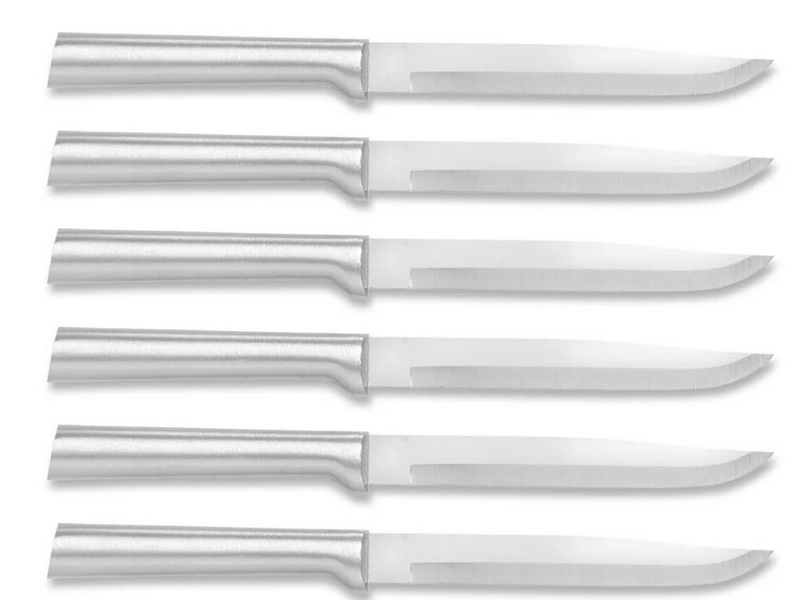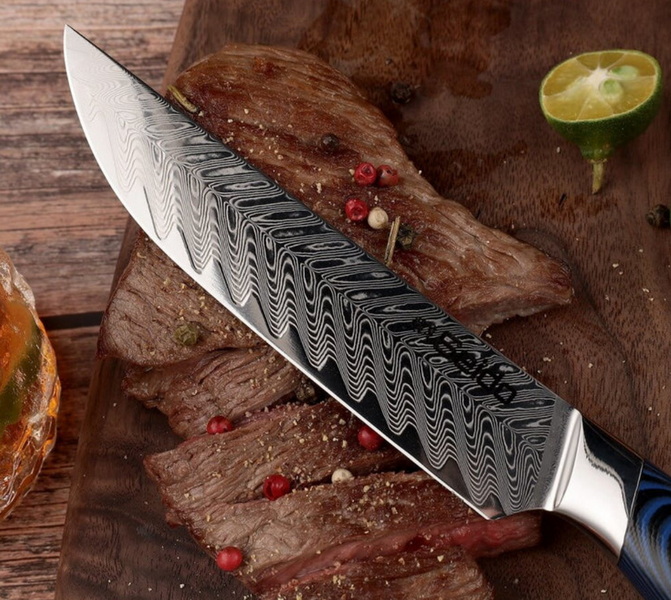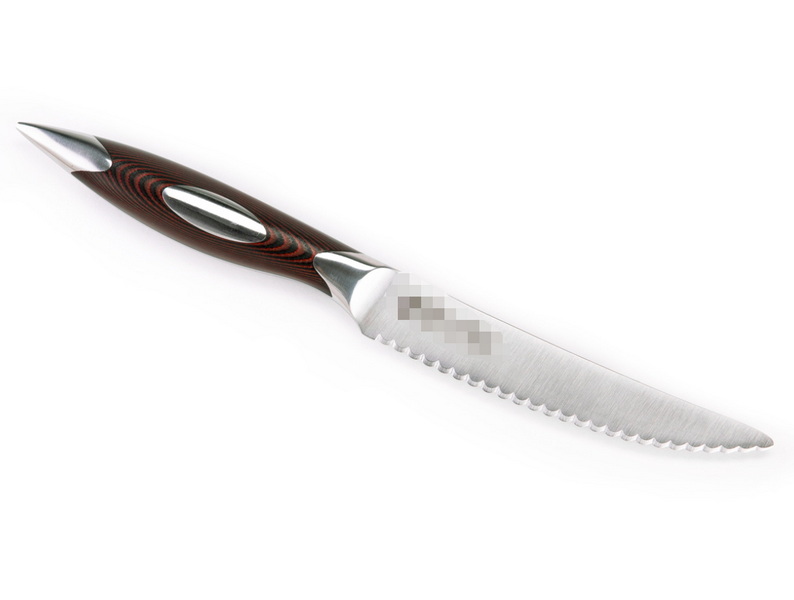- All
- Product Name
- Product Keyword
- Product Model
- Product Summary
- Product Description
- Multi Field Search
Views: 222 Author: Ann Publish Time: 2025-10-30 Origin: Site











Content Menu
>> Steak knives with partial tang vs full tang
● Blade materials and edge geometry
>> High-carbon stainless steels
● Edge angles and grind profiles
● Handle design and ergonomics
>> Materials
>> Corrosion resistance and food safety
● Cultural and market considerations
>> Japanese vs European vs American knife traditions
>> Packaging and branding for international markets
>> Custom logos, private labeling, packaging options
>> Minimum order quantities and lead times
>> Quality control and QC checklists
● Purchasing process for distributors
>> RFQ and supplier evaluation
>> Sample testing and certification
>> Care, maintenance, and lifecycle
>> Cleaning, sharpening, and storage
>> Common issues and troubleshooting
>> Material sourcing and environmental impact
● FAQ
>> 1. What is the difference between forged and stamped steak knives?
>> 2. Which blade material offers the best balance of sharpness and corrosion resistance?
>> 3. How does tang construction affect performance and warranty?
>> 4. What certifications or tests are recommended for international buyers?
>> 5. How should packaging be designed for multi-region distribution?
The global demand for steak knives has grown steadily as professional kitchens, hospitality groups, and discerning home cooks seek higher quality tools that deliver reliable performance. For international distributors, brands, and manufacturers, selecting the right steak knife involves more than choosing a sharp blade. It requires a holistic approach that covers material science, blade geometry, handle ergonomics, finishing options, packaging, and the ability to scale production through OEM partnerships. This guide provides a practical, end-to-end framework to evaluate and source steak knives, with emphasis on the realities of private labeling and original equipment manufacturing (OEM) for mid- to premium-market channels. Throughout, the keyword Steak Knife appears in headings, subheadings, and copy in a natural, consumer-friendly manner to support search optimization while preserving readability for buyers and engineers alike.

Understanding the broad categories helps distributors align product lines with target markets and price tiers. Each type offers distinct advantages in terms of manufacturing complexity, perceived value, and longevity.
Forged blades are created from a single piece of steel that is heated and hammered into shape. This process yields exceptional strength, balance, and edge stability, making forged knives a favored choice for premium brands. The resulting blade typically has a full tang and a seamless transition into the handle, which contributes to improved durability and a more refined balance point. For OEM projects, forged steak knives allow brands to emphasize craftsmanship and longevity, often complemented by high-end materials such as Damascus patterns or premium stainless steels. Finished edges, consistent grinds, and precise heat treatments are critical for delivering reliable performance across batches.
Stamped or punched blades are produced by shearing steel from a sheet and then forming the blade through stamping and finishing operations. This method reduces material costs and allows for faster production cycles, making stamped steak knives a practical option for mid-market offerings with competitive pricing. For private-label programs, stamped blades enable rapid scale, standardized tolerances, and robust repeatability. Surface finishing, grind consistency, and edge retention remain important differentiators when positioning stamped models against forged counterparts.
Damascus blades feature distinctive layered patterns created by folding multiple steel types during forging. The visual appeal and unique texture communicate luxury and exclusivity, often justifying a higher price point. Manufacturing Damascus steak knives at scale presents challenges, including consistent pattern reproduction, edge symmetry, and surface finishing. For OEM partners, Damascus offerings can be paired with premium handle materials and branding elements to create standout product lines that appeal to collectors and gourmet kitchens. Finish options such as etching, laser marking, and specialty packaging can reinforce the Damascus narrative without compromising functional performance.
Tang construction influences balance, strength, and price. Full tang knives run the blade's metal through the handle, typically offering superior stability and resilience under heavy use. Partial tang designs are lighter and more economical, often used in mid-range products where cost control is essential. When negotiating OEM terms, brands should consider target use cases, expected lifetime, and warranty policies to determine the optimal tang type for each model.
The blade material and edge geometry are central to performance, care, and marketing messages. Different steel families offer trade-offs between hardness, toughness, corrosion resistance, and maintenance needs.
Stainless steels balance ease of maintenance with adequate hardness for daily use. Commonly used families include stainless grades designed for culinary applications with good corrosion resistance and corrosion resistance, ease of sharpening, and predictable performance. For example, a typical stainless family in steak knives may emphasize mid-to-high corrosion resistance with a hardness range suitable for comfortable edge retention in home and restaurant settings. Brands often highlight rust resistance, non-reactivity with foods, and viability for dishwasher-safe handling as part of the value proposition.
High-carbon stainless steels provide a balance between edge retention and corrosion resistance. Their higher carbon content allows a sharper edge and longer edge life, though finishing and maintenance can be more demanding than milder stainless options. For OEM programs targeting professional kitchens or enthusiasts who value precision, high-carbon stainless steels enable thinner blades with acute geometries that glide through meat with minimal resistance. Typical considerations include forming stability, heat treatment windows, and the potential for coating or finishing to enhance wear resistance.
Carbon steels deliver exceptional edge sharpness and ease of sharpening for professional users who regularly maintain knives. However, they require more diligent care to prevent rust, especially in humid environments or when exposed to acidic foods. For private-label lines, carbon steel options are often marketed to serious cooks who appreciate performance and are willing to invest in proper care routines. Brands may pair carbon steel blades with premium finishes and presentation packaging to offset maintenance considerations.
Edge geometry significantly influences slicing performance, resistance to dulling, and ease of maintenance. Common configurations include:
- 15–16 degrees per side for very sharp edges aimed at precision slicing, typically found on high-end or competition-grade knives.
- 18–20 degrees per side as a versatile compromise between sharpness and durability, widely used in consumer-grade and mid-range steak knives.
- Hollow-ground edges reduce friction and improve slicing efficiency but can be more susceptible to chipping if mishandled or used on bone.
- Flat-ground or convex grinds influence tough beef cuts and overall durability.

The handle is a critical touchpoint for comfort, control, and user confidence. Selection of handle material, shape, and balance directly impacts user experience and, by extension, brand reputation in international markets.
- Wood: Classic and warm tactile feel; offers traditional aesthetics and premium perception. Proper sealing and maintenance are essential to prevent staining, cracking, or warping.
- POM (polyoxymethylene) and Micarta: Durable, moisture-resistant, and easy to clean. These materials are commonly used in mid-range and premium lines for consistent performance under heavy use.
- Resin and composites: Provide a modern look with varied color options and strong resistance to heat and water. They can be paired with ergonomic curves to enhance grip and control.
- Bakelite, G10, and other composites: Offer high durability in professional environments and strong branding opportunities through color and texture.
- Full tang: Enhances balance and durability, particularly beneficial for serious cooks, professional kitchens, or consumer segments seeking longevity and reliability.
- Partial tang: Keeps production costs lower and can support lower-price offerings. It can still deliver adequate performance for casual home use when paired with well-designed scales and comfortable grips.
Consistent performance across manufacturing batches is essential for building trust with international buyers. Implementing robust testing and documentation helps mitigate warranty issues and strengthens the value proposition.
- Achieved through controlled heat treatment, honing, and protective finishes. For OEM programs, documenting hardness ranges, tempering cycles, and observed edge stability during standardized cut tests can reassure buyers about long-term performance.
- Typical ranges for steak knives span from mid-50s to low-60s (HRC 55–62), depending on material, heat treatment, and intended use. Higher hardness improves edge retention but may reduce toughness and ease of sharpening; balance is key for multi-region markets with varying maintenance capabilities.
- Stainless and coated blades reduce corrosion risk, which is especially important for salty or acidic foods and for environments with high humidity. Packaging, labeling, and certifications (e.g., food-grade coatings, BPA-free handles) support international compliance and consumer confidence.
Market preferences are shaped by regional traditions, culinary styles, and branding expectations. Understanding these nuances enables distributors to align product lines with local expectations.
- Japanese-style knives often emphasize extreme sharpness, thin grinds, and refined balance, with a preference for lighter weight and precise, clean slicing.
- European and American traditions may prioritize robustness, thicker blades, and more comfortable handles designed for longer prep sessions and heavy cutting tasks.
- Communicating these distinctions through product naming, packaging, and marketing content helps buyers select appropriate models for their portfolios and consumer bases.
- Effective packaging communicates quality, safety, and value while standing out on retailer shelves. Considerations include tamper-evident packaging, clear material certifications, and language-appropriate labeling. Private-label strategies benefit from modular packaging designs that can be quickly adapted for different markets, reducing lead times and inventory risk.
A successful OEM partnership requires clear alignment on design intent, production capabilities, and quality controls. The following elements help minimize risk and ensure consistent results.
- Offer a range of customization levels from simple laser-etched logos to fully customized packaging with regional artwork.
- Ensure that the artwork passes print and color standards, and confirm color-matching for packaging materials and blades.
- Establish transparent MOQs that reflect tooling costs, material availability, and production capacity. Provide realistic lead-time estimates for different product tiers and materials, including raw material procurement cycles and holiday season fluctuations.
- Implement a multi-stage QC process: incoming material inspection, in-process checks (grind, heat treatment, balance), finished product inspection (edge geometry, balance, fit in handle), and packaging QA.
- Documentation should include material certificates, process records, and traceability data (batch numbers, production dates, and supplier IDs).
To minimize risk and accelerate procurement, follow a structured process that includes supplier evaluation, sampling, testing, and formal contracting.
- Prepare a comprehensive specification sheet covering blade material, hardness, tang type, handle material, finish, packaging, and certification requirements.
- Request third-party test reports where applicable to verify corrosion resistance, hardness, and safety compliance.
- Receive samples, perform standardized cut tests on a variety of meat types, conduct edge-retention checks after simulated use, and verify ergonomic comfort through grip tests.
- Validate packaging quality, logo fidelity, and labeling accuracy on final samples.
- Clarify price tiers, shipping terms (Incoterms), warranty periods, and responsibility for defects. Include clear escalation paths for quality issues and a robust acceptance criteria document to guide post-shipment inspections.
Educating end-users and providing maintenance guidance reduces premature failure and supports brand reputation for longevity.
- Recommend hand washing and thorough drying to preserve blade finishes. Provide safe sharpening guidance appropriate for each blade type and material, including preferred abrasives, angles, and frequency based on usage patterns.
- Offer storage solutions such as protective sheaths, blade guards, or dedicated drawer organizers that reduce dulling and corrosion risk.
- Common problems include dulling due to improper sharpening, micro-chipping from improper contact with bones or hard surfaces, and handle loosening due to subpar thread engagement or poor grip material selection.
- Provide a troubleshooting guide with clear remediation steps and warranty options to reassure buyers and maintain product satisfaction.
- Emphasize that with proper maintenance, high-quality steak knives can sustain many years of service. Build marketing narratives around lifecycle value, resale potential, and the sustainability benefits of durable, repairable tools when compared with cheaper single-use options.
A growing segment of buyers considers environmental and social governance. Addressing these topics can improve brand perception and market acceptance.
- Outline responsible sourcing, including recycled content, responsible mining practices, and reduced waste in manufacturing. Highlight any third-party certifications or supplier audits that demonstrate compliance with environmental and social standards.
- Encourage packaging optimization to minimize waste, such as using recyclable or compostable materials, designing compact packaging to reduce overall volume, and replacing unnecessary inserts with digital product guides accessible via QR codes.
A well-executed strategy for offering Steak Knife products through international OEM channels combines rigorous material selection, precise blade geometry, ergonomic handle design, and robust quality control. By harmonizing forged, stamped, and Damascus blade options with clear OEM parameters, distributors can build compelling product families that meet diverse market needs—from premium culinary sets to value-oriented lines. The most successful partnerships balance aesthetic appeal, performance, and sustainable manufacturing practices, delivering consistent quality across all SKUs and ensuring reliable supply chains for international buyers.

Forged steak knives are made from a single piece of steel through heating and hammering, offering superior balance, edge stability, and durability. Stamped steak knives are cut from a steel sheet, allowing lower cost and faster production, suitable for mid-market offerings but typically with lighter weight and different balance.
High-carbon stainless steels provide a strong balance between edge retention and corrosion resistance, making them a popular choice for a wide range of steak knife products intended for international markets.
A full tang enhances balance and durability, beneficial for professional use and longer product lifecycles. Partial tang keeps costs lower and can be acceptable for entry-level lines, but may influence warranty scope and perceived longevity.
Recommended tests include hardness testing (HRC), corrosion resistance tests, and food-safety certifications for coatings or finishes. Providing third-party test reports helps satisfy multi-region compliance requirements.
Use modular packaging that supports private labeling across regions, with clear labeling, tamper-evident features, and multilingual inserts or QR codes linking to digital guides. Consider eco-friendly materials and region-specific branding to maximize appeal.
The Ultimate Professional Knives for Halal Butchery in Middle Eastern Kitchens
Chef Knife Size Guide: Choosing Between 6″, 8″, 10″, And 12″
Custom Knife Handles: How To Design A Chef Knife That Fits Your Hand Perfectly
Chef Knife Surface Treatments Guide: From Polished Migaki To Damascus Patterns
Inside Our Professional Knife Sample Room: Quality You Can See
Universal Knife Block Buying Guide: Modern Acrylic & ABS Knife Holders for Professional Kitchens
Universal Knife Block: The Complete Guide To Modern, Hygienic Knife Storage
The Complete Guide To Red Handle Knife Sets: Style Meets Functionality in The Kitchen
Professional Knives for Halal Butchery And Middle Eastern Cuisine